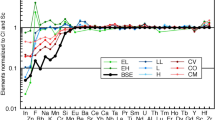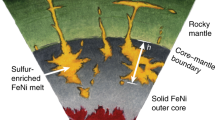Abstract
This paper shows that ferrous silicate meteorites (chondrites), which are conventionally regarded as direct condensates of the primordial solar nebula, are actually igneous and evolved in two stages that were contrasting in their physical and chemical parameters. The origin and early evolution of chondrites went on under enormous fluid pressure, which produced diamond embryos oversaturated with fluid inclusions, and gave rise to isotope abnormality and chondrite structure due to tear-shaped segregation of silicate melt in a Fe-rich diamond-bearing matrix melt. Chondrite crystallization mostly occurred during the second stage, which occurred under low pressure and was characterized by normal fractionation of isotopes and formation of structure opposite to chondrite (containing metal droplets in a silicate matrix), and which involved the formation of volcanic glass.
Similar content being viewed by others
References
King, E., Space Geology, John Wiley&Sons, Inc., 1976.
Ksanfomaliti, L.V., Parad planet (The Celestial Lineup), Moscow: Nauka, 1997.
Cook, W., A New Golden Age of Space Science, America, 1990, no. 2, pp. 6–19.
Marakushev, A.A., Proiskhozhdenie Zemli i priroda ee endogennoi aktivnosti (The Origin of the Earth and the Nature of its Endogenous Activity), Moscow: Nauka, 1999.
Marakushev, A.A., Granovskii, L.B., Zinov’eva, N.G., et al., Kosmicheskaya petrologiya (Space Petrology), Moscow: Nauka, 2003.
Tayler, R.J., The Origin of the Chemical Elements, London: Wykeham and Winchester, 1972.
Shmidt, O.Yu., A Meteoritic Theory for the Origin of the Earth and Planets, Dokl. AN SSSR, 1944, vol. 45, no. 6, pp. 245–249.
Shmidt, O.Yu., Chetyre lektsii o teorii proiskhozhdeniya Zemli (Four Lectures on the Theory of Origin of the Earth), Moscow: Izd-vo AN SSSR, 1957.
Butler, P., Upsilon Andromedae Multipleplaten Systems, Wash. (D.C.): Carnegie Inst., 1999, pp. 110–112.
Charbonneau, D., Atmosphere out of that World, Nature, 2003, vol. 422, pp. 124–125.
Davies, A.G., Lopes-Gantier, R.M.C., Smythe, W.D., et al., Silicate Volcanism on Io, Trans. Amer. Geophys. Union, 1997, vol. 46, p. 419.
Doyle, L.R., Deeg, H.J., and Brown, T.M., Searching for Shadows of Other Earths, Sci. Amer., 2000, vol. 283, no. 3, pp. 58–65.
Fernandez, Y.R., Sheppard, S.S., and Jewitt, D.C., The Albedo Distribution of Jovian Trojan Asteroids, Astron. J., 2003, vol. 126, pp. 1563–1574.
Larson, R.B. and Bromm, V., The First Stars of the Universe, Sci. Amer., 2001, vol. 285, no. 6, December, pp. 64–71.
Marakushev, A.A., Cosmic Petrology and the Planetary Evolution of the Solar System, Astron. and Astrophys. Transactions, 2005, vol. 24, no. 6, pp. 507–519.
Marcy, G.W. and Butler, R.P., Detection of Extrasolar Giant Planet, Ann. Rev. Astron. and Astrophys., 1998, vol. 36, pp. 57–98.
Mohanty, S. and Jayawardhana, R., The Mystery of Brown Dwarf Origins, Sci. Amer., 2006, vol. 294, no. 1, pp. 24–31.
Prentice, A.I.R., The Galilean Satellites of Jupiter, Trans. Amer. Geophys. Union, 1997, vol. 78, no. 46, p. 416.
Rubin, A.E., What Heated the Asteroids?, Sci. Amer., 2005, no. 5, pp. 62–69.
Schulz, L. and Kruse, H., Helium, Neon, and Argon in Meteorites—a Data Compilation, Meteoritics, 1989, vol. 24, pp. 155–172.
Vidal-Madjar, A., Lecavelier des Etang, A., Desert, J.M., et al., An Extended Upper Atmosphere Around the Extrasolar Planet HD209458b, Nature, 2003, vol. 422, no. 6928, pp. 143–146.
Wasson, J.T. and Wang, S., The Histories of Ordinary Chondrite Parent Bodies: U, Th-He Age Distributions, Meteoritics, 1991, vol. 26, pp. 161–167.
Wood, J.A., Origin of the Solar System, Sky and Telescopes, 1999, no. 1, pp. 36–48.
Additional information
Original Russian Text © A.A. Marakushev, 2007, published in Vestnik Moskovskogo Universiteta. Geologiya, 2007, No. 4, pp. 3–11.
About this article
Cite this article
Marakushev, A.A. Space petrology and the planetary evolution of the solar system. Moscow Univ. Geol. Bull. 62, 211–219 (2007). https://doi.org/10.3103/S0145875207040011
Received:
Issue Date:
DOI: https://doi.org/10.3103/S0145875207040011




